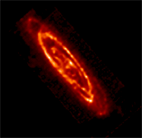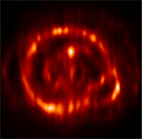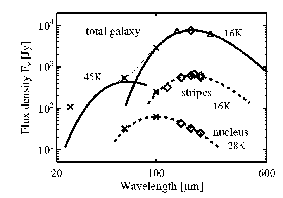 |
|
||||||||||||||||||
|
Cold dust
in the Andromeda galaxy mapped by ISO
|
|||
| A complete 175µm map of the Andromeda galaxy (M31) at 1.’3 resolution shows the distribution of cold dust (Figure 1). It is dominated by a ring at 10 kpc radius supplemented by a faint outer one at 14 kpc. No clear spiral pattern is recognisable (Figure 2). The azimuthally averaged radial brightness profile is rather flat within the 10 kpc ring and decreases exponentially outside thereof, discernible down to a brightness of 0.07 MJy/sr at a distance of 22 kpc. Since the ring comprises a large reservoir for star formation, as an evolutionary conjecture M31 might be in a transition phase changing its classical optical Sb type spiral morphology towards that of a ringed galaxy. | The bulk of the dust has a temperature of only 16 K (Figure 3), considerably colder than the 21-22 K previously inferred from the IRAS data and also colder than the 19 K found for the Milky Way. The cold dust is accompanied by warm dust, formally described by a component at about 45 K. At the common resolution of 2.‘5 the triplet 60/100/175µm flux ratio varies only little across the rings as well as the disk, thus everywhere in M31 at least two dust components are required to fit the far-infrared spectral energy distribution. This provides a direct evidence in M31 for the existence of two dust populations - small and large grains - similar to what had been found in the Milky Way. | ||
 |
Fig.1 |
||
|
|
|||
 |
Fig.2 Face-on deprojection of the 175µm image of M31, adopting a thin disk and an inclination of 75.5 degrees. The major axis lies horizontally, i.e. north-east is on the left. The structure is dominated by the cold ring at 10 kpc radius. No clear spiral pattern is recognisable. The perturbations in the southwest might be caused by the companion galaxy M32. |
||
 |
Fig.3 Infrared spectral energy distribution of M31. The data are shown by symbols (diamonds ISO, crosses IRAS, triangles DIRBE) with the size being larger than the errors.The blackbody curves are shown by lines.The dotted line with T = 22 K through the IRAS 60 and 100µm data points indicates what one would extrapolate from this wavelength range alone without any further assumptions. The data obtained from the map stripes at various wavelengths clearly determine the shape of the energy distribution.They show that there is actually a maximum around 175µm corresponding to a temperature of 16 K which fits the total flux as well. With respect to the dominating 16 K curve the flux shows an excess at 60µm, indicating the presence of accompanying warm dust which is here formally described by a 45 K blackbody. The nucleus (4.‘5 x 4.‘5, 1 x 4 kpc) - after subtraction of the disk contribution - has a temperature of 28 K. |
||